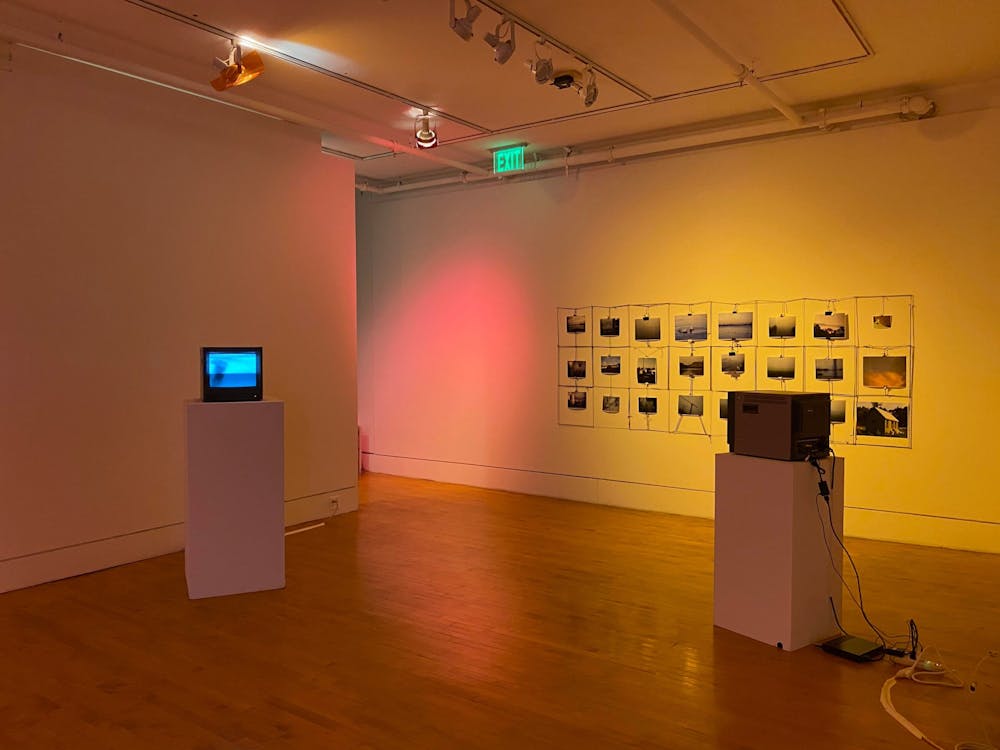“The love and affection I used to have,” a Program in Visual Arts senior thesis show by Ameena Faruki ’22, is a dual act of creation and destruction. On display in the Lucas Gallery at 185 Nassau Street, Faruki’s exhibition draws viewers in with bold asceticism — it is populated sparsely with six cathode-ray tube TVs (CRTs) in the gallery’s small space, bookended by two photography collections. Then, when viewers are in the thick of it, the exhibit comes to life with an evocative, communicative artistic language of its own.
Faruki’s photography is framed distinctively: each of 24 photographs on either side of the exhibit is framed by tied-together ribbons and hung with a pushpin. The framing suggests a dualism of open space and claustrophobia, juxtaposing open landscapes and glittering skies with cloistered indoor spaces. Faruki’s pictures of indoor rooms seem almost surreptitious, glimpsing into empty, liminal areas: here, two tables stacked back-to-back in a dull room that seems much too small for the cluttered storage it holds; there, an unmade bed with wrinkled sheets, white light filtering through a curtain shade. Elsewhere, an eye-popping still life, shrouded in tones of indigo, is interrupted by an encroaching darkness that blots out its entire left half. Humans rarely feature in Faruki’s photographs; the images appear more concerned with presenting the world in vignettes that deliberately obscure the whole for the details.
Against these two photographic collections, the six CRTs that line the exhibition’s center are jarring. The moving-picture form inherent to these televisions implies a continuous cycle of destroying and recreating, as frames segue — sometimes with a striking abruptness — into the next. However, Faruki’s work maintains a semblance of restraint throughout. On one screen, two figures — one masked, one not, the former carrying a hammer — pace about restlessly. On another, a plasticine watering can pours nothing directly onto the viewer’s frame of reference. Arguably the centerpiece of the show, two screens face each other, with just enough room for the viewer to stand between them, inundated at eye-level with the relentless, pendulum-like motion of a hammer on either side.

Aster Zhang / The Daily Princetonian
In the same way as Faruki’s photography, these television screens suggest encroaching claustrophobia and distant diffidence in equal parts. A veil and mask figure prominently across the videos played, concealing the figures’ identities as they move across the screens. Throughout the exhibition, which is structured such that a television screen is always in sight, I felt that the sheer barrenness of these works — which play with nothing but the faint, cold buzzing of the CRTs themselves, all tinted with tinges of ethereally-fluorescent white — were taking and giving at the same time, overwhelming in detachment. Figures flit by, untouchable, recalling multiple-exposure recording techniques in their phantom-like layering. Faruki’s silhouette is visible in one, tipping a watering can into objects unseen. As soon as these images appear, they are gone, replaced with another.
The exhibition gains cohesion from what is arguably its centerpiece, a collection of Faruki’s process notes covered by a veil. Under the veil are scribbled references to the motion of hammers, the positioning of certain backdrop objects, and more; what is presented as motion in Faruki’s television screens are here captured as hastily-drawn stills. Standing in front of it, I registered a sense of sublimation. Faruki suggests the creation of art is endogenous to the creative process itself, and yet it is distilled — presented certainly not in its whole, but rather in only the aspects that are necessary for the show’s sake. In being draped with a veil, moreover, Faruki’s work continues in the presentation of the self as inscrutable, subservient to the artwork it creates.
When I was taking reference pictures of the exhibit for this piece, Faruki warned me that the CRTs don’t show up well in images. “You’ll see,” they said. Indeed, the images of the TVs themselves, when I look back at them in my camera roll, are strikingly corrupted with thick blue stripes that run horizontally back and forth across the screens, rendering the original images unseeable. It’s perhaps unsurprising that there’s an aspect of Faruki’s show that is inaccessible to the record and, to an extent, to the memory, left only to be perceived in the moment itself.
“The love and affection I used to have” is on display in The Lucas Gallery at 185 Nassau Street until Saturday, March 26, 2022.

Aster Zhang is a sophomore and Head Prospect Editor for the ‘Prince.’ They can be reached on Twitter at @aster_zh or on email at brentonz@princeton.edu.









